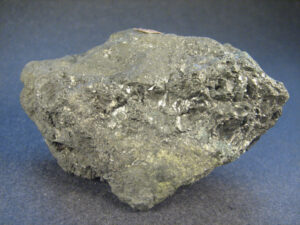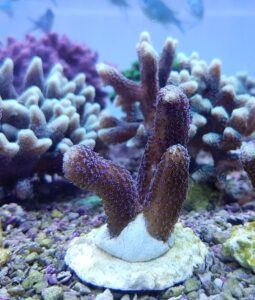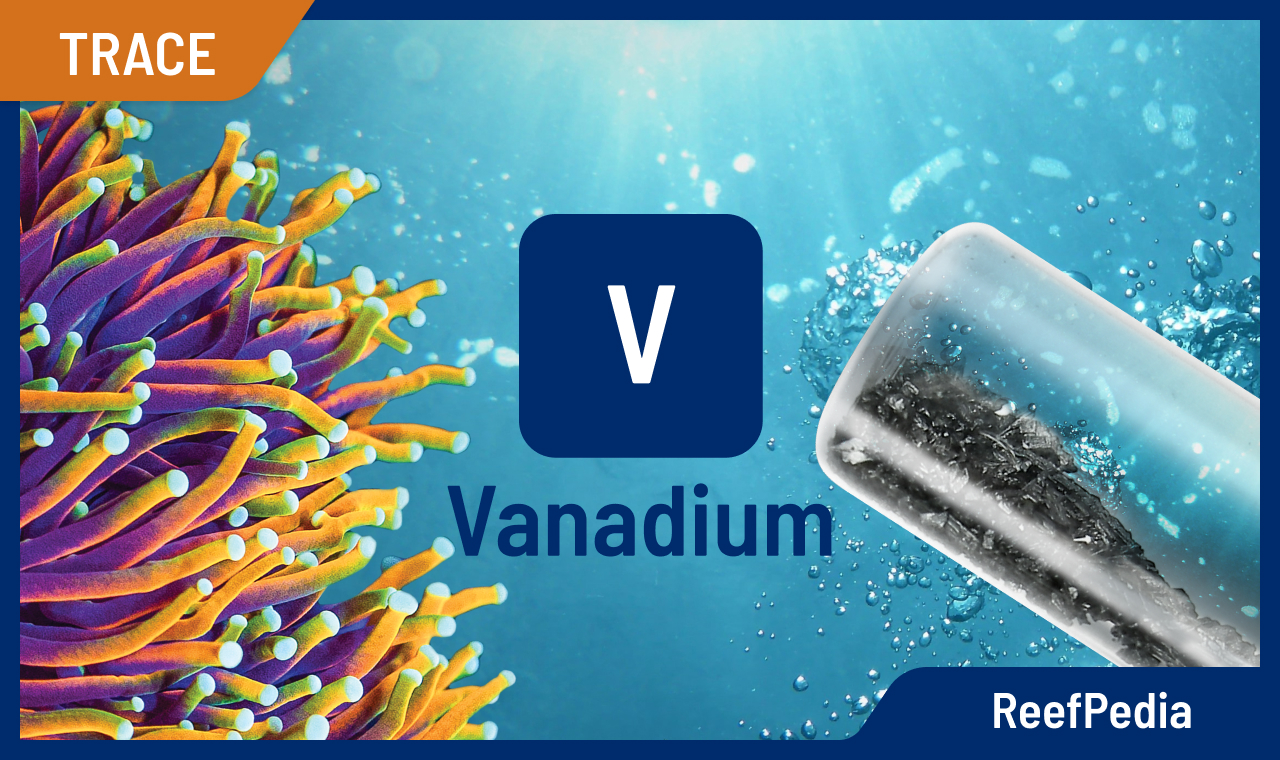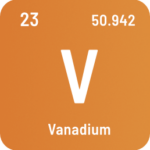 What is VANADIUM (V)?
What is VANADIUM (V)?
Vanadium (V, Latin vanadium) is a chemical element belonging to the elements of the so-called transition groups*. In its pure form, it’s a shiny, grey metal with a blue tint, found in the earth’s crust. The surface of vanadium is most often covered with a layer of vanadium oxides (an oxidized form of vanadium), which are visually responsible for its multicolor. Vanadium, coated with oxides of this element, is referred to as a crystal chameleon. In nature, this element occurs mainly in the form of minerals, such as patronite, carnotite or vanadinite. Vanadium, like molybdenum, forms chemical compounds in which it occurs in various oxidation states (from I to V).
It was experimentally found that, depending on the degree of oxidation of vanadium, its solutions take on different colors: from yellow, through blue, dark green, to violet (in different oxidation states: +V, +IV, +III, +II).
Vanadium is also present in living organisms. in biological processes, and its concentration is low – it varies depending on the species and climatic zone in which the organism lives.
With the development of industry involving vanadium, its level in the natural environment has also increased. From a chemical point of view, vanadium is a heavy metal that does not biodegrade in the natural environment. The high level of vanadium translates into an increase in its accumulation, posing a real threat to organisms, including aquatic creatures.
The optimal level of vanadium, which belongs to the group of microelements in a marine aquarium, is 0.5-3 µg/l. It’s the second, in terms of quantity, microelement found in seawater, right after molybdenum (Mo). In seawater, vanadium occurs in the form of ion pairs Na+ H2VO4– (a system of anion (H2VO4–) and cation (Na+), connected by electrostatic interaction).
The importance of vanadium in seawater
 Vanadium is an essential micronutrient in seawater. It is an essential bioelement, as well as other transition elements: molybdenum (Mo), manganese (Mn), iron (Fe), cobalt (Co), nickel (Ni), copper (Cu) and zinc (Zn). Unlike most of the listed elements, which are essential to all forms of life, functional vanadium compounds have so far been detected in a small number of organisms. Its best known and assimilable form in seawater are vanadium oxides, e.g. sodium metavanadium (Na2VO3). The role of vanadium in corals is species-specific. However, to ensure the health of corals, its trace presence in sea water is necessary.
Vanadium is an essential micronutrient in seawater. It is an essential bioelement, as well as other transition elements: molybdenum (Mo), manganese (Mn), iron (Fe), cobalt (Co), nickel (Ni), copper (Cu) and zinc (Zn). Unlike most of the listed elements, which are essential to all forms of life, functional vanadium compounds have so far been detected in a small number of organisms. Its best known and assimilable form in seawater are vanadium oxides, e.g. sodium metavanadium (Na2VO3). The role of vanadium in corals is species-specific. However, to ensure the health of corals, its trace presence in sea water is necessary.
The roles of vanadium
Biological processes (enzymatic processes)
Different bacteria can use vanadium in different biological processes. Vanadium is distinguished not only by many oxidation states (from -1 to +5), but also by the ability to coordinate with the biological environment in various ways. It’s a component of many enzymes, and one of its functions is participation in the metabolism of glucose and other carbohydrates. It affects the enzymes used by the fixing bacteria that fix the nitrogen needed to reduce nitrous oxide to ammonia. It also participates in the process of denitrification and transformation of inorganic halogens (compounds of elements from the 17th group of the periodic table) into organic molecules.
Biological processes (respiration)
The process of processing vanadium by microorganisms by reduction (detoxification) or using it as an electron acceptor (a permanent elementary particle of an atom with a negative charge) in the process of respiration is known.
Biological processes (growth)
Vanadium is involved in the biological processes taking place in the coral tissue and affects their growth. Its compounds are necessary for the development of sponges, which play an important role in the aquarium ecosystem.
Coloration of corals
Other aspects of the importance of vanadium in seawater are also known, e.g. its presence determines the formation of colored pigments in the structure of corals. You will get the best results when you take care of the optimal ratio of vanadium to molybdenum.
 Problems related to excess or deficiency of vanadium in seawater
Problems related to excess or deficiency of vanadium in seawater
Too low concentration of vanadium leads to difficulties in the process of color production, low color contrast and weakening of the fluorescence effect. An example is Stylophora pistillata, var. “Milka”, which, with a deficiency of vanadium, loses its silvery glowing tips.
Low levels of vanadium also impair the accumulation and breakdown of nutrients. In addition, the lack of vanadium slows down the photosynthesis process. Vanadium deficiency also causes corals to bleach. In this case, we recommend increasing the dose of fluids containing vanadium.
Too high a concentration of vanadium, in turn, can lead to health problems in corals. A large amount of the element in seawater results in darkening of corals. The high concentration of vanadium in seawater affects the growth of algae. The toxicity of vanadium, which occurs mainly in the form of vanadium oxide in seawater, is due to its similarity in chemical structure to the phosphate anion. Too high concentrations of vanadium can relatively replace phosphate in enzymes such as phosphatases and kinases.
How to protect the aquarium?
The vanadium content should be checked regularly and maintained at the correct level. The recommended values are 0.5 – 3 µg/l, and the optimal value is 2 µg/l. Such a level of vanadium in seawater provides animals with health and beautiful coloring (favors light blue and red colors).
The most accurate and reliable method of vanadium determination is the ICP-OES (Inductively Coupled Plasma Optical Emission Spectrometry) analysis.
Indicators of abnormal levels of vanadium in a marine aquarium
Deficiency:
- Pale colors – they become monochromatic
- LPS brightening
- Weak fluorescent effects
- Poor growth
Excess:
- High levels of vanadium are toxic
- Coral darkening
Recommendations
To ensure the proper level of vanadium in your aquarium, you should test it regularly.
If the level of vanadium is above 3 µg/l, we’re dealing with an overdose. The most common reasons for exceeding the recommended level of vanadium are too high doses of administered fluids (check the dosing parameters on the dosing pumps) and improperly prepared salt. Find and eliminate the cause of the problem and lower the value of this parameter in the water. Perform up to 6 water changes. It is recommended that at each water change approximately 15% of the aquarium water volume be replaced, until the recommended value of this parameter is reached. Water prepared for replacement must be characterized by an appropriate level of target salinity. Use salt with the correct parameters and composition for the ICP test.
When the level of vanadium is below 0.5 µg/l, we recommend using products containing this element to compensate for the level. To ensure a constant level of vanadium in a marine aquarium, we recommend systematic supplementation of this element depending on the coral stock in your aquarium.
*The term transition group metals of the periodic table refers to the metals found in groups IB to VIIIB of the periodic table of the elements.
About author

Magdalena Metzler
Privately, I am a mother and a lover of nature and sport. My main interest is quantum chemistry, which hides a whole lot of unsolved mysteries and connections, which is extremely exciting from a scientific point of view.
In my scientific career, I have conducted international projects focused on innovative solutions for many branches of business, e.g. automotive, construction, and now, of course, marine aquaristics.
Working at Reef Factory gave me a passion for marine aquaristics, which I can develop every day, building a chemistry department and creating products that will help aquarists take care of tanks and ensure the highest safety of animals.
One of the most exciting memories of working at Reef Factory is the commissioning of the ICP-OES spectrometer, which analyzes the elemental composition of seawater. The method of analysis in ICP is based on an analytical technique, which is a combination of my passion for quantum chemistry and marine aquaristics.
I hope you find my articles on ReefPedia interesting and helpful! Happy reading :))
Magda


 What is VANADIUM (V)?
What is VANADIUM (V)?